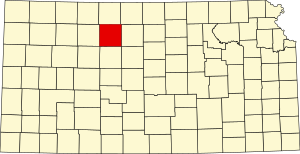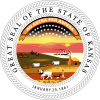Rooks County, Kansas
Rooks County | |
|---|---|
County | |
 Rooks County courthouse in Stockton (2014) | |
 Location within the U.S. state of Kansas | |
 Kansas's location within the U.S. | |
| Coordinates: 39°27′05″N 99°06′07″W / 39.4514°N 99.1019°W | |
| Country | |
| State | |
| Founded | February 26, 1867 |
| Named for | John C. Rooks |
| Seat | Stockton |
| Largest city | Plainville |
| Area | |
| • Total | 895 sq mi (2,320 km2) |
| • Land | 891 sq mi (2,310 km2) |
| • Water | 4.6 sq mi (12 km2) 0.5% |
| Population | |
| • Total | 4,919 |
| • Density | 5.5/sq mi (2.1/km2) |
| Time zone | UTC−6 (Central) |
| • Summer (DST) | UTC−5 (CDT) |
| Congressional district | 1st |
| Website | rookscounty.net |
Rooks County (standard abbreviation: RO) is a county located in the U.S. state of Kansas. As of the 2020 census, the county population was 4,919.[1] The county seat is Stockton,[2] and the largest city is Plainville. The county was named for Private John C. Rooks of the 11th Kansas Infantry who died at the Battle of Prairie Grove near Fayetteville, Arkansas, during the Civil War.[3]
History[]
Early history[]
For many millennia, the Great Plains of North America was inhabited by nomadic Native Americans. From the 16th century to 18th century, the Kingdom of France claimed ownership of large parts of North America. In 1762, after the French and Indian War, France secretly ceded New France to Spain, per the Treaty of Fontainebleau.
19th century[]
In 1802, Spain returned most of the land to France, but keeping title to about 7,500 square miles. In 1803, most of the land for modern day Kansas was acquired by the United States from France as part of the 828,000 square mile Louisiana Purchase for 2.83 cents per acre.
In 1854, the Kansas Territory was organized, then in 1861 Kansas became the 34th U.S. state. In 1867, Rooks County was established.
In 1881, the first county courthouse was built in Stockton. The county jail was built nearby from cottonwood logs strengthened by tons of iron.[4]
20th century[]
In 1923, a new courthouse opened in Stockton. The Rooks County Courthouse was added to the National Register of Historical Places in 2002.
Geography[]
According to the U.S. Census Bureau, the county has a total area of 895 square miles (2,320 km2), of which 891 square miles (2,310 km2) is land and 4.6 square miles (12 km2) (0.5%) is water.[5]
Adjacent counties[]
- Phillips County (north)
- Smith County (northeast)
- Osborne County (east)
- Ellis County (south)
- Trego County (southwest)
- Graham County (west)
Demographics[]
| Historical population | |||
|---|---|---|---|
| Census | Pop. | %± | |
| 1880 | 8,112 | — | |
| 1890 | 8,018 | −1.2% | |
| 1900 | 7,960 | −0.7% | |
| 1910 | 11,282 | 41.7% | |
| 1920 | 9,966 | −11.7% | |
| 1930 | 9,534 | −4.3% | |
| 1940 | 8,497 | −10.9% | |
| 1950 | 9,043 | 6.4% | |
| 1960 | 9,734 | 7.6% | |
| 1970 | 7,628 | −21.6% | |
| 1980 | 7,006 | −8.2% | |
| 1990 | 6,039 | −13.8% | |
| 2000 | 5,685 | −5.9% | |
| 2010 | 5,181 | −8.9% | |
| 2020 | 4,919 | −5.1% | |
| U.S. Decennial Census[6] 1790-1960[7] 1900-1990[8] 1990-2000[9] 2010-2020[1] | |||

As of the census[10] of 2000, there were 5,685 people, 2,362 households, and 1,556 families residing in the county. The population density was 6 people per square mile (2/km2). There were 2,758 housing units at an average density of 3 per square mile (1/km2). The racial makeup of the county was 97.13% White, 1.13% Black or African American, 0.42% Native American, 0.19% Asian, 0.02% Pacific Islander, 0.37% from other races, and 0.74% from two or more races. 1.06% of the population were Hispanic or Latino of any race.
There were 2,362 households, out of which 29.10% had children under the age of 18 living with them, 55.40% were married couples living together, 7.20% had a female householder with no husband present, and 34.10% were non-families. 31.80% of all households were made up of individuals, and 18.50% had someone living alone who was 65 years of age or older. The average household size was 2.32 and the average family size was 2.93.
In the county, the population was spread out, with 25.20% under the age of 18, 6.40% from 18 to 24, 25.50% from 25 to 44, 21.50% from 45 to 64, and 21.50% who were 65 years of age or older. The median age was 40 years. For every 100 females there were 98.10 males. For every 100 females age 18 and over, there were 94.30 males.
The median income for a household in the county was $30,457, and the median income for a family was $36,931. Males had a median income of $26,794 versus $18,389 for females. The per capita income for the county was $15,588. About 7.30% of families and 9.80% of the population were below the poverty line, including 9.70% of those under age 18 and 7.40% of those age 65 or over.
Government[]
Presidential elections[]
Rooks County is overwhelmingly Republican. No Democratic presidential candidate has won Rooks County since Franklin D. Roosevelt – ironically against Kansan Alf Landon – carried the county by eighty-five votes in 1936. The last Democrat to exceed a quarter of the county's vote was Michael Dukakis in 1988 during a major drought on the Great Plains.
Laws[]
Following amendment to the Kansas Constitution in 1986, the county remained a prohibition, or "dry", county until 2000, when voters approved the sale of alcoholic liquor by the individual drink with a 30 percent food sales requirement.[12]
Education[]
Unified school districts[]
- Palco USD 269
- limited to western edge of county; includes Palco, Damar and Zurich
- Plainville USD 270
- southern half of county, except western edge zoned to Palco
- Stockton USD 271
- northern half of county
Communities[]

Cities[]
Unincorporated communities[]
Townships[]
Rooks County is divided into twelve townships. None of the cities within the county are considered governmentally independent, and all figures for the townships include those of the cities. In the following table, the population center is the largest city (or cities) included in that township's population total, if it is of a significant size.
See also[]
|
|
References[]
- ^ Jump up to: a b c "QuickFacts; Rooks County, Kansas; Population, Census, 2020 & 2010". United States Census Bureau. Archived from the original on August 19, 2021. Retrieved August 19, 2021.
- ^ "Find a County". National Association of Counties. Retrieved 2011-06-07.
- ^ Kansas Place-Names,John Rydjord, University of Oklahoma Press, 1972, ISBN 0-8061-0994-7
- ^ Blackmar, Frank Wilson (1912). Kansas: A Cyclopedia of State History, Volume 2. Chicago: Standard Publishing Company. p. 605.
- ^ "US Gazetteer files: 2010, 2000, and 1990". United States Census Bureau. 2011-02-12. Retrieved 2011-04-23.
- ^ "U.S. Decennial Census". United States Census Bureau. Retrieved July 28, 2014.
- ^ "Historical Census Browser". University of Virginia Library. Retrieved July 28, 2014.
- ^ "Population of Counties by Decennial Census: 1900 to 1990". United States Census Bureau. Retrieved July 28, 2014.
- ^ "Census 2000 PHC-T-4. Ranking Tables for Counties: 1990 and 2000" (PDF). United States Census Bureau. Retrieved July 28, 2014.
- ^ "U.S. Census website". United States Census Bureau. Retrieved 2008-01-31.
- ^ http://uselectionatlas.org/RESULTS
- ^ "Map of Wet and Dry Counties". Alcoholic Beverage Control, Kansas Department of Revenue. November 2006. Archived from the original on 2007-10-08. Retrieved 2007-12-26.
Further reading[]
- Standard Atlas of Rooks County, Kansas; Geo. A. Ogle & Co; 67 pages; 1905.
External links[]
| Wikimedia Commons has media related to Rooks County, Kansas. |
- County
- Maps
- Kansas counties
- Rooks County, Kansas
- 1867 establishments in Kansas
- Populated places established in 1867


